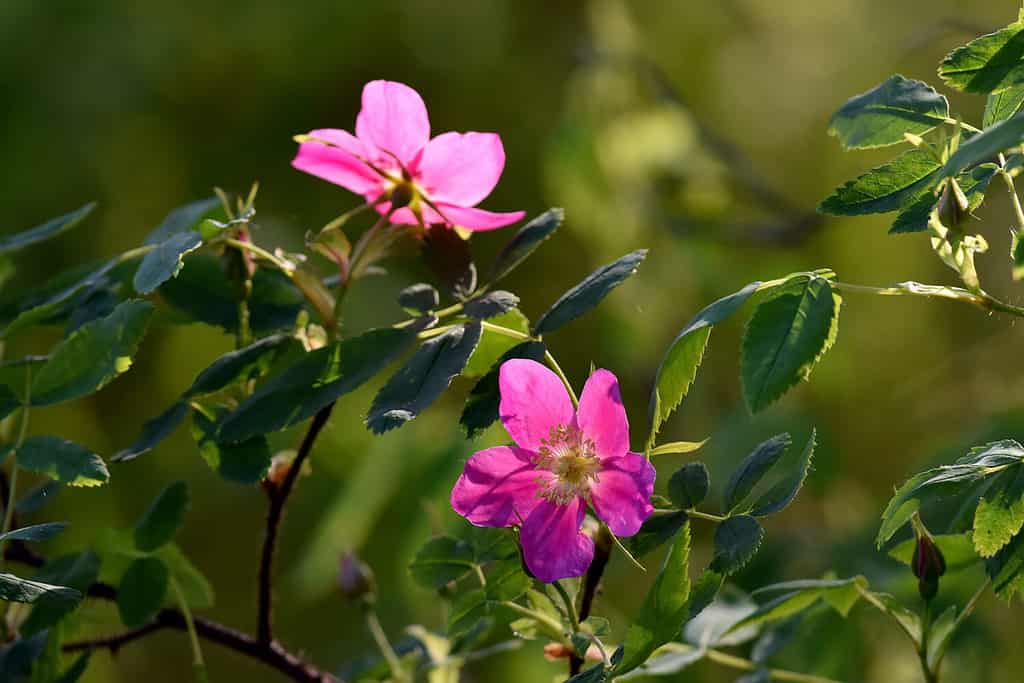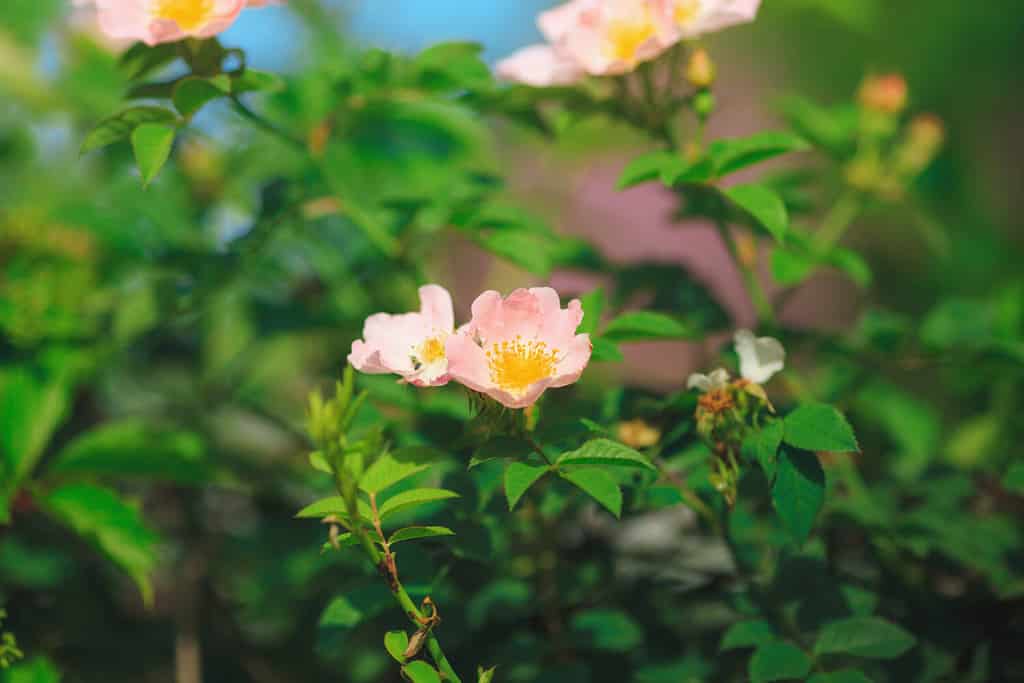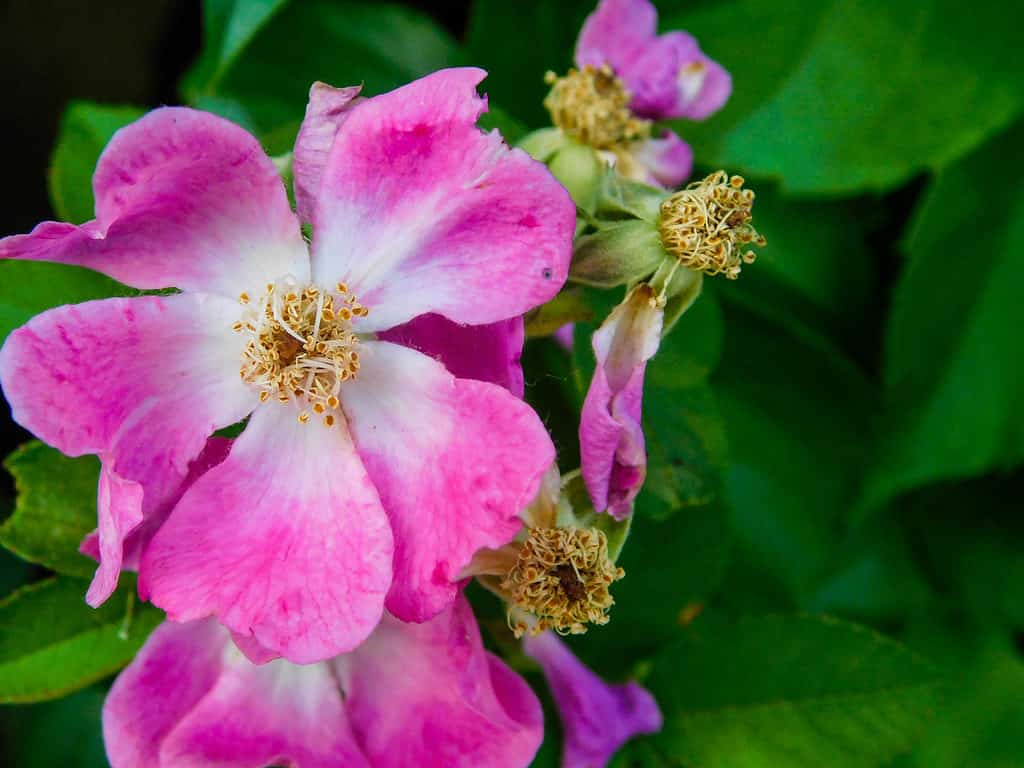There are a ton of different rose species and varieties out there. However, very few are native to Minnesota or have been developed in the North Star State. That being said, we’ve found a few excellent examples of the rare and beautiful roses in Minnesota. Let’s take a look!
1. Prickly Wild Rose
Classification: Rosa acicularis
A lovely natural rose variety that grows in many parts of Minnesota is the Prickly Wild Rose. This exquisite wild rose is well renowned for its distinctive look, delicate scent, and capacity to flourish in a variety of environments.
A deciduous shrub, the Prickly Wild Rose normally grows to a height of two to five feet. The plant gets its name from its many upright stems coated with hooked prickles. The leaves are pinnately complex and feature five to seven elliptical, serrated-edged leaflets. The rose produces beautiful solitary blossoms in the spring and early summer. The flowers have a lovely, delicate aroma and are typically pink. However, they can occasionally be white.
The Prickly Wild Rose grows in a range of environments throughout Minnesota. It flourishes in open wooded areas, meadows, grasslands, and at the sides of roadways. This adaptive plant can thrive in a variety of soil types, from sandy to loamy, and is well-suited to the state’s climate. It is suited for Minnesota’s severe winters because of its strong cold resistance as well.
In addition to its aesthetic appeal, the Prickly Wild Rose has ecological benefits. Its blooms draw bees and butterflies as pollinators, enhancing the local biodiversity. Birds and small animals can get food from the rose hips, which form after the blooms fade, during the fall and winter. Just as well, indigenous people have long employed this species for medical purposes after discovering its potential therapeutic benefits.

The Prickly Wild Rose (pictured) is highly beneficial to the environment in Minnesota.
©JT Fisherman/Shutterstock.com
2. Smooth Wild Rose
Classification: Rosa blanda
One of the best native roses in Minnesota, the Smooth Wild Rose is a charming rose in the state’s environment. This wild rose is a cherished addition to the state’s floral collection thanks to its peculiar characteristics, delicate aroma, and adaptability.
A deciduous shrub, the Smooth Wild Rose normally reaches heights of two to four feet. It may be distinguished from other wild rose species by its smooth, thornless stems and branches. The pinnately complex leaves are made up of serrated leaflets that have an oval or elliptical form. Beautiful pink blooms with a delicate scent are produced by the shrub throughout the summer.
The Smooth Wild Rose grows in a variety of environments throughout Minnesota. It flourishes in open forests, meadows, by the sides of highways, and even in unnatural locations. This resilient plant can endure a variety of soil types, including sandy, loamy, and clayey soils, and is well adapted to the state’s climate.
In addition to being beautiful, the Smooth Wild Rose aids the environment it grows in. Its blossoms draw pollinators like bees and butterflies, enhancing the richness of the nearby habitat. After the petals have faded, the shrub also produces rose hips, which are tiny, red, berry-like fruits. During the fall and winter, these hips are an important source of food for birds and small animals, providing sustenance when other food sources are limited.
The Smooth Wild Rose has cultural significance in addition to its aesthetic value and ecological importance. Indigenous people have utilized it for a variety of uses in traditional medicine, including treatments for skin problems and digestive disorders.
3. Prairie Rose
Classification: Rosa arkansana
The grassland regions of Minnesota are enhanced by the beauty of the local rose species known as the Prairie Rose. This wild rose is a prized member of the state’s flora because of its distinctive look, alluring aroma, and overall hardiness.
The Prairie Rose is a deciduous shrub that normally reaches heights of two to four feet. It has pinnately complex leaves with serrated leaflets and boasts thin, arching stalks covered with thorns. The plant produces eye-catching, five-petaled flowers throughout the summer. The Prairie Rose has a wide range of blossom colors, from soft pink to vivid magenta. Their aroma is seductive and sweet, frequently characterized as a fusion of fruity and flowery overtones.
The Prairie Rose is typically found growing in grassland or prairie areas in Minnesota. It flourishes on wide grasslands, remnants of prairie, and even at the sides of roadways. This versatile plant can survive in a variety of soil types, from sandy soils with good drainage to deep clay soils. It works well with the state’s environment, which includes its chilly winters and sweltering summers.
Beyond its aesthetic and aromatic appeal, the Prairie Rose has ecological advantages. Its blooms draw bees and butterflies, as well as other pollinators, increasing the richness of the nearby habitat. Rose hips, which are tiny, scarlet fruits that appear after the blooms have faded, are also produced by the shrub. In the fall and winter, when food is limited, these hips provide a significant food source for animals, including birds and small mammals. Indigenous people have utilized it for its possible medicinal benefits in traditional medicine, notably in the treatment of conditions like digestive problems and sore throats.

The Prairie Rose (pictured) has been traditionally used to treat digestive and throat problems.
©Batechenkofff/Shutterstock.com
4. Carolina Rose
Classification: Rosa carolina
When we talk about roses in Minnesota, we can’t forget this beauty. Another native rose species that gives Minnesota’s landscapes a touch of beauty is the Carolina Rose. This wild rose is a treasured member of the state’s flora because of its distinctive look, exquisite aroma, and adaptability.
A deciduous shrub with an average height of two to four feet, the Carolina Rose. It has arched branches covered with prickly thorns. The complex, pinnate leaves have serrated leaflets that have a light glossy sheen. The flowering plant produces gorgeous pink blossoms with a sweet aroma in the summer. Any garden or natural environment will benefit from the aroma, which is frequently characterized as sweet and spicy and adds a lovely sensory experience.
The Carolina Rose may be found growing in a variety of environments in Minnesota. It grows well in meadows, open woods, and at the borders of forests. This adaptive plant can live in a variety of soil types, including sandy, loamy, and clayey soils, and is well adapted to the state’s climate.
Beyond aesthetic and fragrant appeal, the Carolina Rose has ecological advantages. Its blossoms draw pollinators like bees and butterflies, enhancing the richness of the nearby habitat. Rose hips are also produced by the shrub. During the fall and winter, these hips are an important food source for birds and small animals, giving sustenance and assisting in seed dissemination.
There is a long history of conventional usage for the Carolina Rose. Native American cultures used numerous plant components for medical purposes, including the treatment of fevers and digestive problems. The rose hips were also eaten for their vitamin C content.
5. Climbing Prairie Rose
Classification: Rosa setigera
Another indigenous rose species that enhance Minnesota’s surroundings with beauty and adaptability is the Climbing Prairie Rose. This wild rose is a notable contribution to the state’s floral diversity because of its distinctive look, delicate scent, and climbing behavior.
This deciduous vine-like shrub can grow to remarkable heights, frequently ascending 10 to 20 feet with the assistance of a trellis or similar structure. It has stems that are thin, arching, and covered with thorns. Serrated leaflets make up the complex, pinnate leaves of this species. The shrub produces lovely pink blooms with a pleasant, delicate scent in the summer.
The southern parts of Minnesota are where you may find the Climbing Prairie Rose growing. It favors disturbed places, the borders of forests, and open woods. This adaptive plant can live on sandy, loamy, and clayey soils, among other environmental variations.
The Climbing Prairie Rose’s propensity to climb is one of its distinctive characteristics. It has thorny branches that allow it to cling to and climb over other plants or buildings. Due to this quality, it is a fantastic option for adding vertical interest to landscapes or establishing natural barriers.
Like other roses, the Climbing Prairie Rose attracts pollinators like bees and butterflies, enhancing the richness of the regional ecology. Rose hips are also produced by it. Birds and small animals may survive the fall and winter months on these hips, which are crucial food sources.

The Climbing Prairie Rose (pictured) is an excellent choice for gardeners who want wall cover.
©iStock.com/Wirestock
6. Sunrise Sunset Rose
Classification: Rosa ‘Sunrise Sunset’
A beautiful hybrid rose recognized for its lovely scent and gorgeous colors is the Sunrise Sunset Rose. William A. Warriner, a prominent hybridizer at the renowned rose breeding firm Jackson & Perkins, created this rose variety.
A stunning color gradient may be seen in the daybreak dusk Rose, which changes from a delicate yellow at daybreak to a bright orange-red at dusk. The blossoms have a touch of elegance thanks to the petals’ ruffled and somewhat fringed look. The clusters of medium-sized, semi-double blooms have two petals on each side. The plant grows into a compact shrub that usually stands between three and four feet tall.
The Sunrise Sunset Rose has a wonderful smell that is frequently characterized as a fusion of fruity and spicy undertones. This rose type is favored for gardens and cut flower bouquets because the smell boosts its overall charm.
The Sunrise Sunset Rose may be grown well in a number of garden configurations in Minnesota. It does best on well-drained soil and needs at least six hours of direct sunlight each day to develop and blossom to its full potential. To guarantee good air circulation and reduce the danger of infections, it’s critical to provide enough space between each plant.
The Sunrise Sunset Rose is famous for its capacity to rebloom all during the growing season. It blooms profusely in late spring or early summer, then keeps flowering all summer long until the end of the growing season. Its attraction is increased by the longer flowering season, which also guarantees a consistent display of brilliant hues in the landscape.
7. Multiflora Rose
Classification: Rosa multiflora
In many areas of Minnesota, the Multiflora Rose, an imported species of rose, has spread like wildfire. The Multiflora Rose is a beautiful plant with a nice scent, but because of its fast growth and capacity to outcompete native species, it poses serious threats to natural habitats in the state.
This species is a deciduous shrub with a height range of 10 to 15 feet or more. It has canes that arch and are coated in tiny, hooked thorns in great numbers. Its compound leaves have five to eleven leaflets with serrations. The plant produces clusters of tiny, white to pinkish blooms in the spring and summer. The blossoms have a pleasant, delicate scent that is reminiscent of roses in general.
The Multiflora Rose grows in a range of disturbed environments in Minnesota, including fields, roadsides, forest margins, and deserted places. Areas with poor soil conditions are where it is most common. Due to its remarkable adaptability, the plant is able to withstand a variety of environmental factors, including both full sun and partial shade.
The Invasive Nature of Multiflora Roses
The Multiflora Rose’s invasiveness is a pretty significant issue in Minnesota. It creates thickets that outcompete native plants for resources, decreasing biodiversity and altering natural environments. Once established, it is challenging to control because of its fast growth and propensity for seed production.
The Multiflora Rose has various advantages despite its invasiveness. It yields rose hips that may be used to make herbal medicines, jellies, and teas since they are high in vitamin C. Its dense thickets can also provide ground cover and a place for small mammals and birds to nest.
Multiflora Rose is being managed and controlled in Minnesota using a variety of tactics, such as mechanical removal, herbicide use, and biological control techniques. To maintain the integrity of native ecosystems, it is crucial to stop the spread of this invasive species.

Multiflora Roses (pictured) might be beautiful, but they are considered an invasive species in Minnesota.
©weha/Shutterstock.com
8. Peachy Knock Out
Classification: Rosa ‘Radgor’
A popular and colorful rose cultivar called the Peachy Knock Out Rose is renowned for its profusion of peach-colored flowers and outstanding disease resistance. William J. Radler, a well-known rose breeder and the brains behind the Knock Out rose line, introduced this hybrid rose.
The medium-sized, semi-double blooms of the Peachy Knock Out Rose are displayed in clusters, and they have an alluring peachy-orange color. The petals have a little ruffled look, which gives the flowers more texture and depth. The plant itself is a little shrub that normally grows to be between three and four feet tall and wide. Although the Peachy Knock Out Rose isn’t well recognized for its fragrance, it makes up for it with its abundance of flowers and adaptability to different growing environments.
The Peachy Knock Out Rose may flourish in a range of garden environments in Minnesota. It can thrive in both full sun and moderate shade and is tolerant of a broad variety of soil conditions. It is a hardy rose cultivar that can resist the region’s severe winters and erratic weather patterns.
The Peachy Knock Out Rose stands out for a number of reasons, including its outstanding disease resistance. It is resistant to the common rose diseases blackspot and powdery mildew which frequently afflict other rose kinds. Because of this feature, it is a dependable and low-maintenance option for gardeners looking for a lovely and robust rose.
The photo featured at the top of this post is © aaddyy/Shutterstock.com
Thank you for reading! Have some feedback for us? Contact the AZ Animals editorial team.






